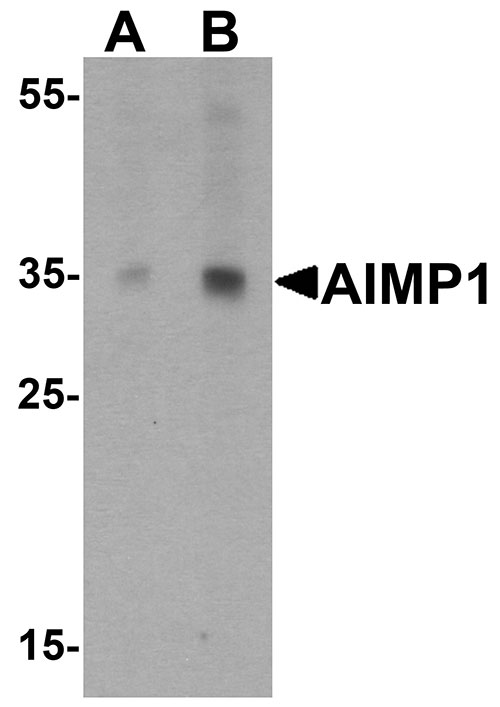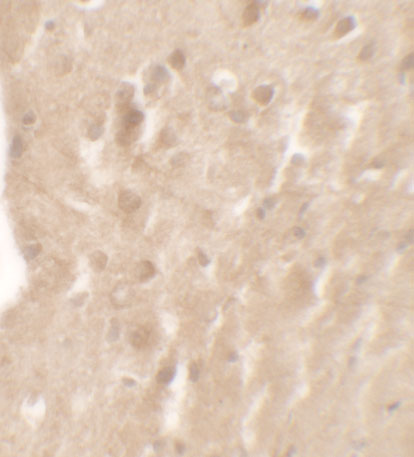AIMP1 Antibody
- 产品详情
- 实验流程
- 背景知识
Application
| WB, E, IHC-P |
|---|---|
| Primary Accession | Q12904 |
| Other Accession | NP_001135888, 215490011 |
| Reactivity | Human, Mouse, Rat |
| Host | Rabbit |
| Clonality | Polyclonal |
| Isotype | IgG |
| Calculated MW | 34353 Da |
| Concentration (mg/ml) | 1 mg/mL |
| Conjugate | Unconjugated |
| Application Notes | AIMP1 antibody can be used for detection of AIMP1 by Western blot at 0.5 - 1 µg/ml. |
| Gene ID | 9255 |
|---|---|
| Other Names | Aminoacyl tRNA synthase complex-interacting multifunctional protein 1, Multisynthase complex auxiliary component p43, Endothelial monocyte-activating polypeptide 2, EMAP-2, Endothelial monocyte-activating polypeptide II, EMAP-II, Small inducible cytokine subfamily E member 1, AIMP1, EMAP2, SCYE1 |
| Target/Specificity | AIMP1; AIMP1 antibody is human, mouse and rat reactive. At least two isoforms of AIMP1 are known to exist; this antibody will recognize both isoforms. AIMP1 antibody is predicted to not cross-react with AIMP2. |
| Reconstitution & Storage | AIMP1 antibody can be stored at 4℃ for three months and -20℃, stable for up to one year. |
| Precautions | AIMP1 Antibody is for research use only and not for use in diagnostic or therapeutic procedures. |
| Name | AIMP1 |
|---|---|
| Synonyms | EMAP2, SCYE1 |
| Function | Non-catalytic component of the multisynthase complex. Stimulates the catalytic activity of cytoplasmic arginyl-tRNA synthase (PubMed:10358004). Binds tRNA. Possesses inflammatory cytokine activity (PubMed:11306575). Negatively regulates TGF-beta signaling through stabilization of SMURF2 by binding to SMURF2 and inhibiting its SMAD7- mediated degradation (By similarity). Involved in glucose homeostasis through induction of glucagon secretion at low glucose levels (By similarity). Promotes dermal fibroblast proliferation and wound repair (PubMed:16472771). Regulates KDELR1-mediated retention of HSP90B1/gp96 in the endoplasmic reticulum (By similarity). Plays a role in angiogenesis by inducing endothelial cell migration at low concentrations and endothelian cell apoptosis at high concentrations (PubMed:12237313). Induces maturation of dendritic cells and monocyte cell adhesion (PubMed:11818442). Modulates endothelial cell responses by degrading HIF-1A through interaction with PSMA7 (PubMed:19362550). |
| Cellular Location | Nucleus. Cytoplasm, cytosol. Secreted. Endoplasmic reticulum {ECO:0000250|UniProtKB:P31230}. Golgi apparatus {ECO:0000250|UniProtKB:P31230}. Note=Enriched in secretory vesicles of pancreatic alpha cells and secreted from the pancreas in response to low glucose levels (By similarity). Secreted in response to hypoxia (PubMed:10850427). Also secreted in response to both apoptotic and necrotic cell death. {ECO:0000250|UniProtKB:P31230, ECO:0000269|PubMed:10850427} |
For Research Use Only. Not For Use In Diagnostic Procedures.
Provided below are standard protocols that you may find useful for product applications.
BACKGROUND
AIMP1 (Endothelial monocyte-activating polypeptide II, EMAP2) is a proinflammatory cytokine for monocytes and granulocytes (1). It is specifically induced by apoptosis and is involved in the control of angiogenesis, inflammation, and wound healing (1,2). AIMP1 was identified as one of three auxiliary factors of the mammalian aminoacyl tRNA synthetase (ARS) complex. It binds and facilitates the catalytic reaction of arginyl-tRNA synthetase (2,3). Recent studies show that CD23 plays an essential role in the AIMP1-induced immune response and might be a target in the treatment of inflammatory diseases (4).
REFERENCES
Park SG, Jung KH, Lee JS, et al. Precursor of pro-apoptotic cytokine modulates aminoacylation activity of tRNA synthetase. J. Biol. Chem. 1999; 274:16673–6.
Park SG, Shin H, Shin YK, et al. The novel cytokine p43 stimulates dermal fibroblast proliferation and wound repair. Am. J. Pathol. 2005; 166:387–98.
Quevillon S, Agou F, Robinson JC, et al. The p43 component of the mammalian multi-synthetase complex is likely to be the precursor of the endothelial monocyte-activating polypeptide II cytokine. J. Biol. Chem. 1997; 272:32573–9.
Kwon HS, Park MC, Kim DG, et al. Identification of CD23 as a functional receptor for the proinflammatory cytokine AIMP1/p43. J. Cell Sci. 2012; 125:4620-9.
终于等到您。ABCEPTA(百远生物)抗体产品。
点击下方“我要评价 ”按钮提交您的反馈信息,您的反馈和评价是我们最宝贵的财富之一,
我们将在1-3个工作日内处理您的反馈信息。
如有疑问,联系:0512-88856768 tech-china@abcepta.com.























 癌症的基本特征包括细胞增殖、血管生成、迁移、凋亡逃避机制和细胞永生等。找到癌症发生过程中这些通路的关键标记物和对应的抗体用于检测至关重要。
癌症的基本特征包括细胞增殖、血管生成、迁移、凋亡逃避机制和细胞永生等。找到癌症发生过程中这些通路的关键标记物和对应的抗体用于检测至关重要。 为您推荐一个泛素化位点预测神器——泛素化分析工具,可以为您的蛋白的泛素化位点作出预测和评分。
为您推荐一个泛素化位点预测神器——泛素化分析工具,可以为您的蛋白的泛素化位点作出预测和评分。 细胞自噬受体图形绘图工具为你的蛋白的细胞受体结合位点作出预测和评分,识别结合到自噬通路中的蛋白是非常重要的,便于让我们理解自噬在正常生理、病理过程中的作用,如发育、细胞分化、神经退化性疾病、压力条件下、感染和癌症。
细胞自噬受体图形绘图工具为你的蛋白的细胞受体结合位点作出预测和评分,识别结合到自噬通路中的蛋白是非常重要的,便于让我们理解自噬在正常生理、病理过程中的作用,如发育、细胞分化、神经退化性疾病、压力条件下、感染和癌症。







